Common menu bar links
Economic Developments and Prospects
- Canada’s employment performance is the best it has been in 30 years, consumer confidence remains high and business financial positions are healthy.
- Canadian real gross domestic product (GDP) growth slowed modestly in recent quarters as a result of weaker U.S. demand, the past appreciation of the Canadian dollar and a cooling of the Canadian housing market.
- Private sector forecasters expect growth to improve during the course of 2007, with real GDP growth of 2.3 per cent in 2007 and 2.9 per cent in 2008. These forecasts are consistent with the U.S. economy achieving an expected soft landing in the wake of the recent correction to the U.S. housing market.
- The Canadian economy faces a number of risks over the budget-planning horizon.
- The principal domestic risk is that recent weakness in productivity growth reflects lower underlying productivity growth rather than cyclical factors, which would have negative implications for Canada’s future growth potential.
- The downside risk to U.S. residential construction activity appears to have lessened since the November 2006 Economic and Fiscal Update, although there remains a risk that the weak U.S. housing market could negatively affect U.S. consumer demand. As well, world oil prices remain volatile and subject to geopolitical risks. Higher oil prices would push up the Canadian dollar, making Canadian exports less competitive.
Introduction
This chapter discusses recent economic developments and prospects. It presents the economic-planning assumptions that underlie the Government’s budget plan and examines a number of risks and uncertainties associated with the economic outlook.
U.S. Economic Developments and Outlook
The U.S. economy slowed in mid-2006 as a result of a sharp housing market correction (Chart 2.1). The pace of economic activity remained moderate in the final quarter of 2006, as the preliminary National Accounts estimates revealed U.S. real GDP growth of 2.2 per cent. This reflected a continued contraction in residential investment as well as a substantial slowdown in the pace of inventory accumulation, which was largely offset by a jump in consumer spending growth. The improvement in consumer spending was mainly due to strong real disposable income growth, reflecting solid wage-income gains and a sharp decline in energy prices. For 2006 as a whole, U.S. real GDP grew 3.3 per cent, up slightly from 3.2 per cent in 2005.
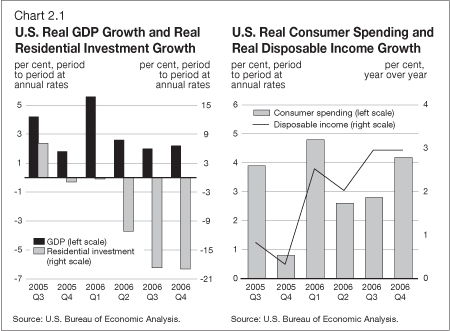
Recent building permit and mortgage application data suggest that the worst of the housing market correction may be over. However, the inventory overhang in housing remains sizeable and should keep new residential construction on a downward path through the early part of 2007 (Chart 2.2). As well, ongoing weakness in the manufacturing sector, as evidenced by slowing shipments growth, points to continued softness in the pace of inventory investment. Together, these factors suggest that growth in the first half of 2007 will remain subdued.
Consumer spending is expected to remain solid, reflecting ongoing income gains. Business investment is expected to bounce back after weakening in late 2006 and to remain an important contributor to overall growth, buoyed by low interest rates and healthy profits. As the drag from residential investment diminishes, private sector forecasters expect growth to gradually strengthen in the latter half of 2007.
Private sector forecasters expect U.S. real GDP to grow by 2.5 per cent in 2007 and 2.9 per cent in 2008. Relative to the November 2006 Economic and Fiscal Update, the forecast for 2007 is unchanged, while the forecast for 2008 is 0.2 percentage points lower.
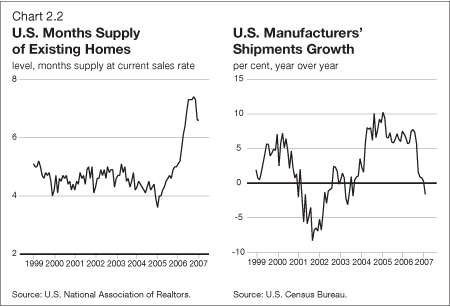
Overseas Economic Developments and Outlook
Global growth exceeded 3 per cent for the third consecutive year in 2006. Over the next two years, the global expansion is projected to moderate somewhat but remain solid, led by ongoing strength in China and broadening growth in the euro zone and Japan (Chart 2.3).
In the euro zone, real GDP growth is expected to moderate slightly to 2.2 per cent in 2007 and 2.1 per cent in 2008, with improved job conditions supporting consumption growth. Real GDP growth in the United Kingdom is expected to remain strong, increasing 2.6 per cent in 2007 and 2.5 per cent in 2008, reflecting strong domestic demand.
In Japan, economic growth is expected to remain solid, reflecting ongoing strength in business investment due to favourable financial conditions and high corporate profits. Japanese real GDP is expected to grow 2.1 per cent in 2007 and 2.2 per cent in 2008. China’s growth is expected to remain strong, driven by solid business investment and export growth.
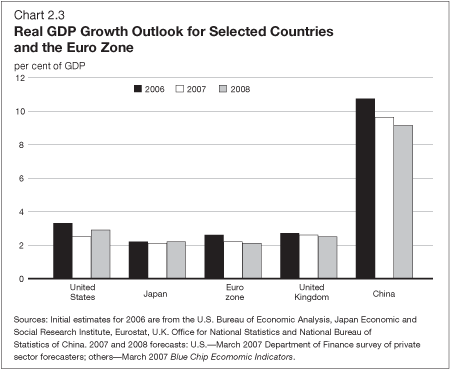
Canadian Economic Developments
Canadian economic growth has slowed since the first quarter of 2006 (Chart 2.4). Much of the slower growth reflects a decline in manufacturing output, which is due to slower U.S. demand and the past appreciation of the dollar, as well as ongoing structural problems in the automobile and textile and clothing sectors.
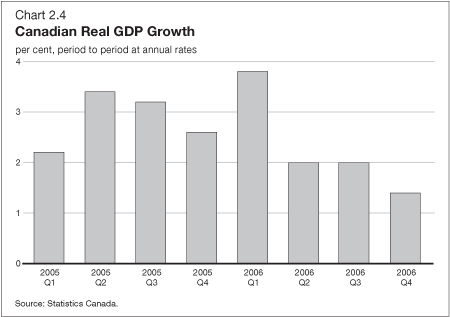
Manufacturing’s share of total output has been declining in all Group of Seven (G7) countries over the past 35 years (Chart 2.5). This long-term trend reflects the increasing importance of the service sector as well as an ongoing shift in the location of lower-valued manufacturing activity to low-cost manufacturing countries. Although Canadian manufacturing’s share of the economy grew solidly between 1993 and 2000, this was largely a result of the weak dollar during that period. The sharp appreciation of the Canadian dollar that began in 2003 has put downward pressure on manufacturing exports, and as a result the long-term decline in manufacturing’s share of output has resumed.
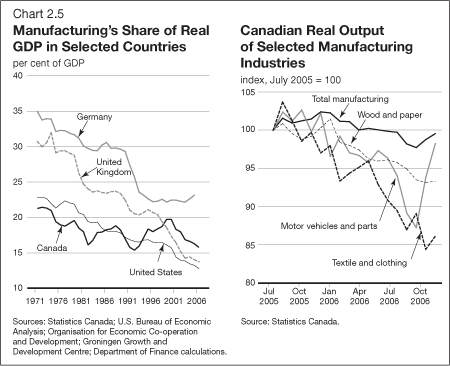
The manufacturing sector has been particularly weak in the past year, with real output declining by 2.8 per cent between December 2005 and December 2006. This decline reflects four factors: the strength of the Canadian dollar; the slowing U.S. economy; restructuring among the Big Three U.S. automakers (General Motors, Ford and DaimlerChrysler); and increasing competition from low-wage countries in some sectors.
The decline in manufacturing output in 2006 has been particularly pronounced in housing-, automobile- and textile-related industries (Chart 2.5). Wood products manufacturing and related industries have experienced a steep drop in output in response to a rapidly deteriorating U.S. housing market. Production of motor vehicles and parts fell for much of 2006, reflecting sluggish North American demand for automobiles and restructuring by the Big Three U.S. automakers. The clothing and textile industry continues to be affected by competition from low-cost countries such as China.
Manufacturing industries generally remain profitable, and debt-equity ratios have been quite stable. Manufacturers’ overall profit margin in the fourth quarter of 2006 was slightly above its historical average of 6.0 per cent. Moreover, real investment in machinery and equipment in the manufacturing sector has been healthy, increasing by 4.3 per cent in 2006 compared to an average of only 3.2 per cent over the past 35 years. The U.S. economy is expected to pick up over the course of 2007, which should help to support growth in most manufacturing industries. However, North American vehicle sales and production may weaken further over the near term, partly reflecting reduced capacity of automakers to offer generous incentives as well as excess production capacity among the Big Three U.S. automakers. In the medium term, prospects for the automobile sector are brighter—a total of $7 billion in new investments has been announced within the industry over the past few years. On the other hand, the shift out of low-value-added industries like clothing and textiles as a result of growing competition from countries like China is a long-term trend that is likely to continue.
Weakness in manufacturing, especially the automobile sector, was reflected in slower goods export growth in 2006 (Chart 2.6). However, auto exports rebounded in the fourth quarter, largely due to production delays in the third quarter.
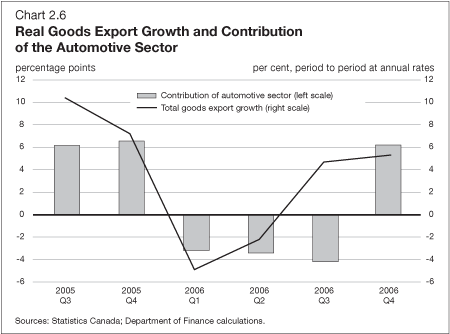
Following a prolonged period of strong growth, housing starts eased to more sustainable levels in the last three quarters of 2006 (Chart 2.7). Alberta’s housing market continues to outperform the housing market in the rest of the country, as the strong energy sector attracts workers to the province. The Canadian housing market correction has been much less pronounced than in the U.S. The level of mortgage indebtedness is much lower in Canada than in the U.S. (Chart 2.7). Since 2005, inventories of houses for sale have grown rapidly in the U.S. to levels last seen in the mid-1990s, while Canadian inventories have remained below their historical average.
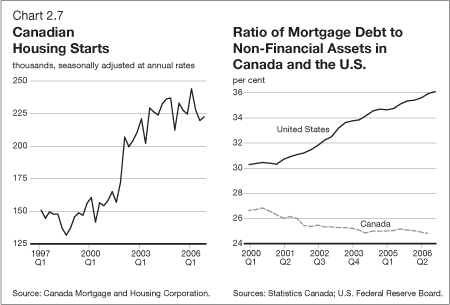
Consumer spending increased a healthy 3.1 per cent in the fourth quarter, following a very strong 5.1 per cent growth in the third quarter (Chart 2.8). Healthy expenditures on services and on big-ticket items such as furniture and automobiles were partially offset by reduced spending on non-durable goods. Warmer than usual weather may have contributed to declines in purchases of home energy. Consumer spending grew by 4.1 per cent in 2006, its best performance since 1997, supported by healthy consumer confidence, rising household net worth and strong real disposable income growth.
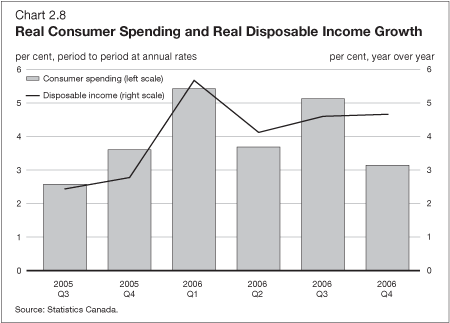
Canadian business non-residential investment grew a strong 6.0 per cent in the fourth quarter of 2006 and 9.2 per cent for the year as a whole. Investment has been supported by historically low interest rates, high corporate profits (Chart 2.9), strong business confidence and low machinery and equipment (M&E) prices associated with the high value of the Canadian dollar. M&E investment grew 8.0 per cent in 2006. Investment in non-residential structures also continued to rise strongly, owing in part to strong investment in engineering construction in the oil and gas sector.
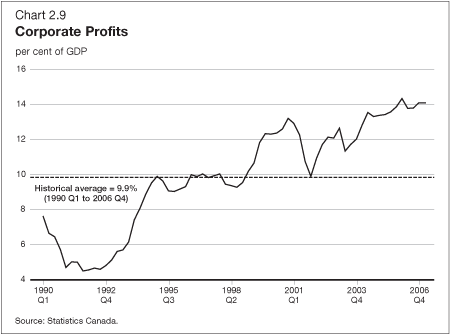
Canadian employment grew by almost 350,000 in 2006, the strongest growth since 2002. Employment growth in 2007 got off to a good start with more than 100,000 new jobs created in the first two months of the year. Since the beginning of 2006, three-quarters of the gains have been in full-time positions. While employment has fallen in manufacturing industries, it has risen strongly in most other sectors, particularly mining and oil and gas. All regions of the country have experienced employment gains, with Alberta and Saskatchewan experiencing the strongest growth (Chart 2.10). As a result of the strong job creation, the unemployment rate fell to 6.1 per cent in February 2007, which matches the lowest level in 32 years.
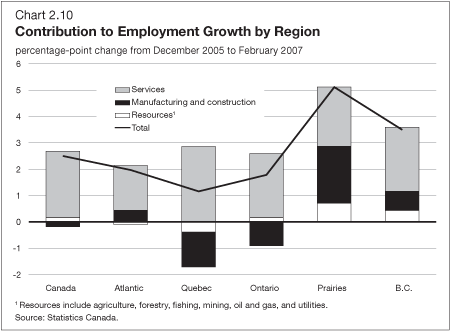
Strong growth in employment combined with slowing output growth resulted in a sharp fall in year-over-year labour productivity growth from 2.0 per cent in the fourth quarter of 2005 to 0.6 per cent in the fourth quarter of 2006. Most of this decline has occurred in industries where growth has weakened noticeably, such as manufacturing, reflecting the fact that changes in employment and average hours of work tend to lag downturns in output.
The price of West Texas Intermediate (WTI) crude oil fell from around US$77 per barrel in August 2006 to US$50 per barrel in mid-January 2007 as a result of a very warm early winter and slowing global oil demand growth. The WTI price has since increased to around US$60 per barrel, reflecting a return to normal winter weather and expectations of a firming U.S. economy.
The decline in crude oil prices since last summer has put downward pressure on the Canadian dollar, which has weakened by around 5 per cent against the U.S. dollar from 90.47 cents U.S. in August 2006 (Chart 2.11).
Inflation remains subdued, with the Consumer Price Index (CPI) up 1.2 per cent (year over year) in January and core CPI inflation up 2.1 per cent, which is very close to the 2-per-cent inflation target.
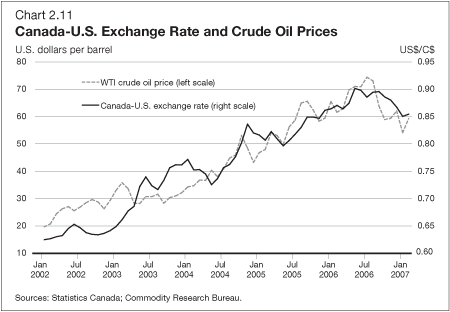
Private Sector Canadian Outlook
The Department of Finance surveys private sector economic forecasters on a quarterly basis regarding their outlook for the Canadian economy. The Department’s survey of private sector forecasters forms the basis for economic assumptions that underlie the fiscal projections for the budget.
The economic forecasts reported here reflect a survey of private sector forecasters conducted by the Department in March following the release of the 2006 fourth-quarter National Income and Expenditure Accounts by Statistics Canada on March 2.
Real GDP growth of 1.4 per cent in the fourth quarter of 2006 was lower than the 2.7 per cent growth expected at the time of the November 2006 Economic and Fiscal Update. Third-quarter growth was also lower than expected at the time of Update 2006 (2.0 per cent versus 2.4 per cent). Private sector forecasters expect real GDP growth to strengthen over the course of 2007, as the impact of the past appreciation of the Canadian dollar dissipates and U.S. demand growth strengthens.
Despite this anticipated pickup, private sector forecasters expect real GDP growth in 2007 to be 2.3 per cent, down from 2.7 per cent expected at the time of Update 2006. This downward revision reflects weaker than expected growth in the second half of 2006, which lowered the level of real GDP at the beginning of 2007 by 0.4 per cent. This translates into a similar reduction in 2007 growth. Private sector forecasters have slightly lowered their forecasts of real GDP growth in 2008 to 2.9 per cent from 3.0 per cent expected at the time of Update 2006, in part because of slower U.S. growth.
Private sector forecasters have lowered their forecasts for GDP inflation in 2007, partly because of a larger than expected decline in oil prices in the second half of 2006. They now expect GDP inflation of 1.5 per cent in 2007, down from 1.9 per cent in Update 2006. They have raised their outlook for GDP inflation in 2008 slightly to 2.0 per cent.
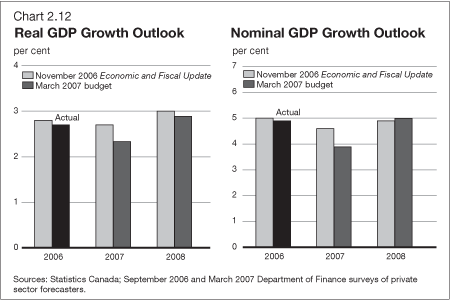
As a result, the outlook for nominal GDP growth in 2007 has been revised down from 4.6 per cent in Update 2006 to 3.9 per cent. The outlook for nominal GDP growth in 2008 has been revised up slightly from 4.9 per cent in Update 2006 to 5.0 per cent.
At the time of Update 2006, the private sector forecasters expected short-term interest rates to average 3.9 per cent in 2007 and 4.2 per cent in 2008. The current private sector outlook is moderately higher in 2007 but unchanged for 2008, with short-term rates averaging 4.2 per cent in both years.
Interest rates on 10-year government bonds are expected to average 4.1 per cent in 2007, 0.2 percentage points lower than expected at the time of Update 2006, and 4.5 per cent in 2008, essentially unchanged from Update 2006.
Private sector forecasters expect the labour market in Canada to remain healthy, with the unemployment rate averaging 6.3 per cent in 2007 and 6.4 per cent in 2008, lower than expected at the time of Update 2006. Their outlook for employment growth has been revised up to 1.5 per cent in 2007 and 1.3 per cent in 2008.
Table 2.1Private Sector Forecasts for 2007 and 2008
(per cent, unless otherwise indicated)
| 2006 | 2007 | 2008 | |
|---|---|---|---|
| Real GDP growth | |||
| May 2006 budget | 3.0 | 2.7 | 2.9 |
| November 2006 Economic and Fiscal Update | 2.8 | 2.7 | 3.0 |
| March 2007 budget | 2.7 | 2.3 | 2.9 |
GDP inflation |
|||
| May 2006 budget | 2.9 | 1.8 | 1.6 |
| November 2006 Economic and Fiscal Update | 2.1 | 1.9 | 1.9 |
| March 2007 budget | 2.2 | 1.5 | 2.0 |
Nominal GDP growth |
|||
| May 2006 budget | 6.0 | 4.6 | 4.6 |
| November 2006 Economic and Fiscal Update | 5.0 | 4.6 | 4.9 |
| March 2007 budget | 4.9 | 3.9 | 5.0 |
Nominal GDP level (billions of dollars) |
|||
| May 2006 budget1 | 1,454 | 1,520 | 1,590 |
| November 2006 Economic and Fiscal Update | 1,440 | 1,506 | 1,580 |
| March 2007 budget | 1,439 | 1,495 | 1,570 |
3-month treasury bill rate |
|||
| May 2006 budget | 4.0 | 4.1 | 4.3 |
| November 2006 Economic and Fiscal Update | 4.1 | 3.9 | 4.2 |
| March 2007 budget | 4.0 | 4.2 | 4.2 |
10-year government bond rate |
|||
| May 2006 budget | 4.4 | 4.5 | 5.1 |
| November 2006 Economic and Fiscal Update | 4.3 | 4.3 | 4.6 |
| March 2007 budget | 4.2 | 4.1 | 4.5 |
Unemployment rate |
|||
| May 2006 budget | 6.6 | 6.6 | 6.7 |
| November 2006 Economic and Fiscal Update | 6.4 | 6.5 | 6.5 |
| March 2007 budget | 6.3 | 6.3 | 6.4 |
Employment growth |
|||
| May 2006 budget | 1.5 | 1.2 | 1.4 |
| November 2006 Economic and Fiscal Update | 1.8 | 1.2 | 1.2 |
| March 2007 budget | 1.9 | 1.5 | 1.3 |
U.S. real GDP growth |
|||
| March 2006 survey of private sector forecasters | 3.2 | 2.8 | 3.1 |
| November 2006 Economic and Fiscal Update | 3.4 | 2.5 | 3.1 |
| March 2007 budget | 3.3 | 2.5 | 2.9 |
Addendum |
|||
| U.S. real GDP growth | |||
| May 2006 budget | |||
| (April 2006 Blue Chip Economic Indicators) | 3.4 | 3.0 | n/a |
| October 2006 Blue Chip Economic Indicators | 3.4 | 2.6 | 3.1 |
| March 2007 Blue Chip Economic Indicators | 3.3 | 2.5 | 3.0 |
| 1 Nominal GDP levels have been adjusted to reflect May 2006 revisions to Canada’s National Income and Expenditure Accounts. Sources: Statistics Canada; March 2006, September 2006 and March 2007 Department of Finance surveys of private sector forecasters; April 2006, October 2006 and March 2007 Blue Chip Economic Indicators. |
|||
Risks and Uncertainties
The principal domestic risk for the outlook relates to future productivity growth. The downside risk to U.S. residential construction activity appears to have lessened since the November 2006 Economic and Fiscal Update, although there remains a risk that the weak housing market could negatively affect U.S. consumer demand. As well, although world oil prices have eased from last summer’s highs, they remain volatile and subject to geopolitical risks.
Domestic Risk
Productivity growth is volatile and difficult to predict. After strengthening in 2005, labour productivity growth weakened noticeably in 2006. This slowing has been most pronounced in the cyclically sensitive industries, such as manufacturing, which have been negatively affected by slower growth in the U.S. and the past appreciation of the Canadian dollar. The downturn in productivity growth in manufacturing alone accounted for about three-quarters of the slowing in total economy productivity growth during 2006. Canada experienced similar cyclical slowdowns in productivity growth in 2001 and 2003 (Chart 2.13).
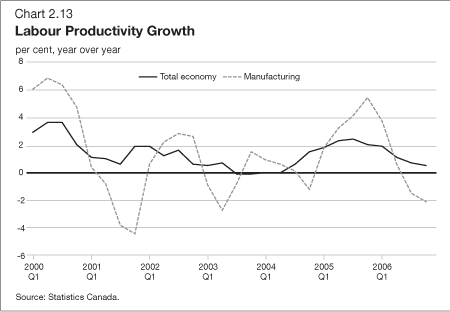
The private sector economic outlook is consistent with a cyclical strengthening in productivity growth as U.S. growth rebounds in 2008 and the impact of the past appreciation of the Canadian dollar dissipates. However, there is a risk that the source of the observed weakness in productivity growth reflects lower underlying productivity growth rather than cyclical factors, which would have negative implications for Canada’s future growth potential. On the other hand, continued solid business investment should bode well for future productivity growth.
External Risks
While some further contraction is likely in the U.S. housing sector, recent indicators suggest that the worst of the contraction may be over and that the downside risk to construction activity has lessened. Nonetheless, inventories remain high, suggesting that weakness will persist in the first part of 2007. To date, the spillover effects of the contraction to consumer spending and other areas of the U.S. economy have been limited, although some of these effects may have been temporarily masked by lower energy prices. There is still a risk that lower housing wealth accumulation could affect consumer spending more than expected, especially given the negative household saving rate.
Commodity price uncertainty continues to be a risk to the outlook. Crude oil prices have fallen from their August peak and are now closer in real terms to their historical averages. This fall, combined with a higher probability of a U.S. soft landing, suggests that the risk of future sharp declines in oil prices has diminished. Nevertheless, commodity prices are volatile and oil prices remain vulnerable to geopolitical risks. Rising oil prices could put upward pressure on the Canadian dollar, which would present a challenge to Canadian firms that are highly exposed to trade.
Table of Contents - Previous - Next -
